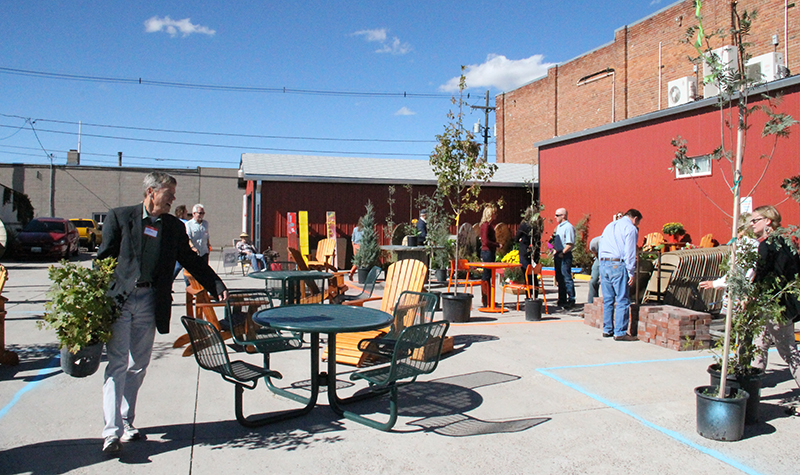Flexibility, Planning Lead to Pop-Up Business Success
 By Matt Ashby, AICP CUD, and Amanda Arnold, AICP
By Matt Ashby, AICP CUD, and Amanda Arnold, AICP
In last week’s blog, we talked about the benefits of pop-ups to your community and its businesses, residents, and local government. With the potential to bolster downtowns suffering from empty storefronts, while creating opportunities for emerging or expanding businesses and also securing income for landlords, embracing pop-ups is way to enhance your downtown during challenging times and potentially create a more secure future.
The first and perhaps most important tip is:
Be Flexible and Have Fun!
Pop-ups are experiments, so be prepared to learn from them. Take advantage of the opportunity to be creative. Collect data on what works and what doesn’t and be prepared to pivot.

About the Expert:
Matt Ashby, a certified urban planner, helps communities nationwide tell their stories and bring new life to blighted properties. His enthusiasm for vibrant community development sharpens the focus of Ayres’ work on brownfield redevelopment, transportation planning, urban park and recreation planning, and landscape architecture.

About the Expert:
Amanda Arnold has a passion for community development and outreach. She researches and analyzes data related to social, housing, commercial development, economic, population, environmental, and land use trends. She develops comprehensive, Main Street, and other urban plans and conducts downtown redevelopment studies.
And now let’s get into the specifics:
What Do Retailers Need to Know about Pop-Ups?
- Know your goals. Determine if you are expanding sales, developing a brand, or just seeing if bricks and mortar is for you. Set goals, measure, and learn.
- Create a budget. Understand how you want your space to look and feel and estimate how much it will cost. Understand your return on investment.
- Understand insurance and permitting requirements. Talk to your insurance carrier about insuring a temporary space and ask your jurisdiction about potential zoning and business licensing issues.
- Consider partnering. Creating a unique temporary space may give you an opportunity to engage with other retailers or community groups.
- Understand your staffing and operations costs. You may need additional staff to cover the pop-up. You’ll want to understand Internet access and other utilities to make sure they support your operations.
- Consider augmenting your pop-up with events. Explore opportunities for people to be socially distanced but also enjoy your pop-up with others. Time your pop-up opening with a larger community event.
- Integrate your pop-up and your online presence. Make sure visitors know about online options and make sure online patrons know about the pop-up.
- Measure your success. Track visits by time of day and sales to see if your pop-up is adding to your bottom line and, better yet, to understand if it has the potential to become permanent.
What Do Building Owners/Landlords Need to Know?
- Support creativity and diversity. Pop-ups give you a chance to take a risk on a unique idea or to support a more diverse set of retail options.
- Test new leasing strategies. Pop-ups can allow you to support “pop-up-to-permanent” leases. If a pop-up lease is successful, you can replicate it in multiple locations, or on and off over time.
- Set standards. Come to agreed-upon standards for how the pop-up will look and function.
- Know your budget. Assess how much you are willing to invest in the space to get it ready for the tenant. Make sure you have the resources to allow the pop-up to be successful, such as Wi-Fi, a secure environment, and necessary maintenance.
- Have a good contract. Establish written expectations for rent, insurance, maintenance, and the amount of time the space will be used.
- Understand insurance and permitting requirements. Talk to your insurance carrier about insuring a temporary space, and ask your jurisdiction about potential zoning and business licensing issues.
- Work with adjacent property owners. Make sure the pop-up will augment adjacent business and not distract from them.
- Make a marketing plan for your space. Market your space to get the type of pop-up you want. Also, be ready for folks to gain a fresh view of your building – you just might get some purchase offers.
What Does Local Government Need to Know?
- Partner with a local Main Street Organization, DDA, Chamber of Commerce, or Economic Development Agency to explore identification of prospective businesses and buildings.
- Work with building officials to build buy-in. Pop-ups might not fit easily into your local codes. Establishing a partnership can help create a problem-solving team rather than empowering problem-finders.
- Promote the public benefits of a pop-up. Frame it in terms of economic development (sales tax) and entrepreneur support. Reducing vacant spaces and historic preservation are also viable local government purposes that can be advanced by a pop-up.
If you’re ready to start, but not quite sure how, Ayres can guide your community through the process of identifying potential pop-up sites and businesses that can use those spaces. We’ll walk you through the decisions that will have to be made and discuss lessons learned from others who have embraced pop-ups. Contact Matt Ashby or Amanda Arnold for more information.

Post a comment: